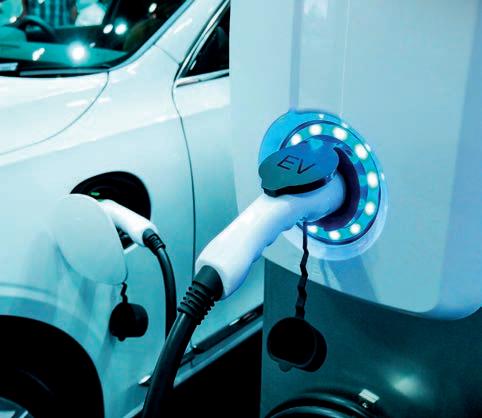TEST EQUIPMENT
SPECIAL FEATURE
A QUALITY FIRST APPROACH TO EV CHARGING Michael Kenyon MIET, Technical Lead at Bureau Veritas, explores the importance of electrical safety and why regular inspection and maintenance is critical for any EV charging installation.
T
he adoption of electric vehicle (EV) technology continues to move at a rapid pace. With the UK government recently unveiling its 10 point plan for a green industrial revolution, it bought forward the ban on selling new petrol and diesel cars from 2035 to 2030 – in order to speed up Britain’s transition to zero emission vehicles, such as EVs. There are now around 339,000 registered EVs in the UK, with pure electric models the only category of growth currently in the UK. With such a dramatic rise in vehicle sales (registrations of pure EVs were up 112% in the first eight months of 2020 compared to 2019), it was evident that the UK’s charging infrastructure would need to increase to cope with demand. In many ways, the private sector has led the way, supported by generous incentive schemes. From offices, supermarkets and car parks, to retailers, business centres and universities, organisations across a wide range of sectors are installing EV charging points. The benefits include income generation, increased footfall, improved sustainability across fleets and even better staff engagement. And with incentives of up to £14,000 per organisation available through the Government’s Workplace Charging Scheme, many would argue that for any organisation with the space and resources to install EV charging points, there is no better time to invest. McDonalds is one major organisation which agrees. In June last year it announced plans to introduce charging points at both new and existing drive-through restaurants in the UK. And clearly it is not alone. Recent statistics from Zap-Map show there are now 33,779 charging points for electric vehicles in the UK, up 39% in the last 12 months alone. The government has pledged to invest a further £500m in the rollout of new rapid electric charging hubs to ensure drivers are never more than 30 miles from being able to charge their car.
Support from electrical experts
A quality first approach
“A quality first approach is the key to unlocking the potential and maintaining the long-term integrity and availability of our charging infrastructure.”
GTC 400 C PROFESSIONAL THERMAL CAMERA Precise. Reliable. Efficient.
As with any rapid deployment of relatively young technology, the onus now is on the quality and safety of such installations. Like any fixed electrical installation, duty holders are required under the Electricity at Work Regulations 1989 (EAWR) to ensure the safety of EV charging points. This includes maintaining systems to prevent, so far as is reasonably practicable, any danger to employees, visitors or other persons. In addition to EAWR, there are a number of other documents used for guidance and to demonstrate compliance, including BS7671 Requirements for Electrical installations, Guidance Notes including GN3 (IET) and BS7671 Section 722 – Electric Vehicle charging installations. Notably, duty holders should take into consideration that EV charging points are a high use asset, often installed outside and therefore vulnerable to mechanical damage and ingress of water. Periodic inspection and at least annual testing are critical to help maintain the long-term integrity of charging points.
Of course, this expertise is not always available in-house, which is why Bureau Veritas has launched a new independent inspection offering for EV charging points to help duty holders ensure all installations are compliant with relevant regulations. This new service provides an independent assessment of all new installations to identify any issues that may present an electrical safety risk. Conducted by Bureau Veritas’ highly skilled electrical engineers, the testing and inspection programme includes a thorough internal and external visual inspection, together with earth continuity and polarity confirmation, and functional testing. Checks on residual current devices and earth loop impedance are also included all designed to help maintain the safety and long-term integrity of these vital assets. It offers a trusted service, helping organisations to identify faults earlier and maintain compliance with workplace and electrical safety legislation. Not forgetting access to a full range of fixed electrical testing and inspection services from Bureau Veritas experts.
Future of EV charging At a time when more and more organisations are installing EV charging points to tap into the benefits and keep up with the UK’s shift to electric, a quality first approach is the key to unlocking the potential and maintaining the long-term integrity and availability of our charging infrastructure. The technology and the incentives are now firmly in place to continue the roll-out of EV charging points across the private sector, in line with EV sales. We must make sure the quality and safety of installations are keeping pace. Bureau Veritas, bureauveritas.co.uk
Make the invisible visible
▶ Measuring range -10°C to +400°C ▶ Big 3.5" colour display to display measurements
▶ Infrared sensor resolution of 160 x120 (19,000 single measurement points)
▶ Visual camera integrated to save real image together with thermal images
It’s in your hands. Bosch Professional.
electricalcontractingnews.com
Test Equipment – Bureau Veritas.indd 41
@ElecConNews
/electricalcontractingnews
March 2021 | 41
25/02/2021 16:01




















